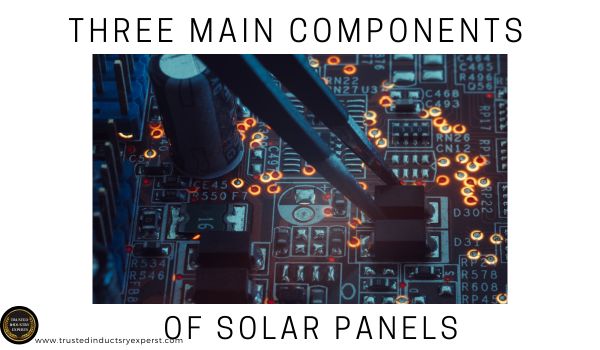
Understanding the Composition of Solar Panels
Solar panels are a crucial component of a solar energy system and are responsible for converting the sun’s energy into usable electricity. It’s essential to understand what they are made of, and how the different materials used in their construction affect their efficiency, durability, and lifespan. In this article, we’ll take a deep dive into the composition of solar panels and explore the key materials used in their construction.
Solar panels are composed of all the components necessary to convert light into usable electricity. This includes the structure, cell material, and protective coating. The most common type of solar cell material is crystalline silicon, which is used in both polycrystalline and monocrystalline solar cells. This type of material has higher light transmission rates than other types of solar cell materials.
Crystalline Silicon Solar Cells (CSCs) are made up of single-crystal or polycrystalline silicon wafers and have a higher efficiency rate than other types of solar photovoltaic cells. They also have an increased lifespan due to their durable structure and construction. CSCs can withstand extreme temperatures, humidity, and other environmental conditions better than other types of solar cells making them ideal for long-term use.
The Three Main Components of Solar Panels

Solar panels consist of three main components: the solar cells, the frame, and the backsheet. Each of these components plays a critical role in the overall function and performance of the solar panel.
Solar panel manufacturers employ a variety of techniques to construct different types of solar panels depending on the application.
Monocrystalline solar panels are made from multiple solar cells composed of monocrystalline silicon cells arranged in a grid-like pattern. These thin film solar cell are connected together and laminated with a thin layer of transparent material for protection and added efficiency. This allows the sun’s light to pass through more efficiently and increases the overall power output of the system. Thin film or amorphous silicon solar panels are composed of multiple thin layers of amorphous silicon deposited on top of each other. This type of solar cell is less efficient than monocrystalline silicon cells, but is much cheaper and easier to manufacture in large quantities.
Solar Cells
Solar cells, also known as photovoltaic (PV) cells, are the heart of the solar panel. They are made of silicon, which is a material that has a unique property of producing an electrical current when exposed to sunlight. Solar cells are usually made of either monocrystalline or polycrystalline silicon, both of which have different advantages and disadvantages.
Monocrystalline silicon
It is made from a single crystal structure and is known for its high efficiency and durability. On the other hand, polycrystalline silicon is made from multiple crystals and is less efficient but less expensive to produce.
The aluminium metal frame is the outermost layer of a solar panel, providing support and protection from environmental conditions. It also helps to create an effective electrical connection between the PV system and external wiring.
The backsheet, which is often made of ethylene vinyl acetate (EVA) or fluoropolymer, provides an additional layer of insulation and protection. On the inside of the panel is a glass casing that protects the cells from dust and debris. Underneath this casing are the solar cells, which are typically made of crystalline silicon but can also be constructed using cadmium telluride or quantum dots.
Crystalline silicon solar cells have higher efficiency rates but come with higher production costs, while Cadmium Telluride (CdTe) or Quantum Dot (QD) solar cells tend to be less expensive but less efficient overall. Ultimately, what type of cell material is used depends on factors such as cost effectiveness, wattage output and efficiency ratings for each specific application.
In addition to the traditional monocrystalline and polycrystalline solar cells, bifacial solar cells are becoming increasingly popular. These cells are designed to absorb light from both sides of the panel, allowing them to convert more sunlight into electricity than a standard solar panel. Bifacial solar cells also have a higher conversion efficiency than other types of silicon cell due to their increased surface area for capturing light. They can also be used in conjunction with regular monocrystalline or polycrystalline solar panels to increase the overall solar power output of the system.
By combining these different types of cells, it is possible to create an efficient and reliable system for harnessing renewable energy from the sun. With an increasing focus on renewable energy sources, bifacial solar cells can be a great way to maximize the efficiency of a home or business’ solar power setup while reducing environmental impact.
Frame
The frame of a solar panel is responsible for providing support and protection to the solar cells. It is usually made of aluminum or other durable materials that are resistant to weathering and corrosion. The frame also plays a critical role in mounting the solar panel to a roof or other surface.
Thin film solar cells, also known as photovoltaic (PV) cells, are an alternative to traditional crystalline silicon-based solar cells. These cells are typically made of copper indium gallium selenide (CIGS) or amorphous silicon, and they provide a more efficient way of converting the sun’s energy into electricity than their silicon counterparts. Thin film solar cells use less material in their construction, allowing them to be more lightweight and cost-effective. They are also able to absorb more solar radiation than crystalline silicon cells due to the increased surface area of their thin layers.
In addition, CIGS can operate at higher temperatures than crystalline silicon, making them better suited for hot climates or areas with limited cooling systems. By combining different types of materials such as CIGS with molten silicon and other conductive elements such as silver, solar cells can be constructed in a variety of shapes that allow for greater efficiency when it comes to producing electricity from sunlight. This means that thin film solar cells can offer an efficient solution for harnessing renewable energy from the sun while reducing environmental impact.
Backsheet
The backsheet of a solar panel is a layer of material that protects the back of the panel from moisture and other environmental elements. It is usually made of a material such as polyvinyl fluoride (PVF) that is resistant to water and UV light. The backsheet also helps to prevent electrical short circuits and ensures that the solar panel operates safely and efficiently.
The cells of a solar panel are encased in an anti-reflective coating, which increases the efficiency of the cell by reducing the losses caused by reflection and refraction of light. This coating also helps to protect the cell from wear and tear due to its exposure to weather conditions.
Additionally, solar cells are composed of semiconductor materials such as crystalline silicon modules, which are used to convert sunlight into electricity. These materials are durable, temperature-resistant, and contain no hazardous chemicals or pollutants.
The crystalline silicon modules contain two layers of semiconductor material that absorb and convert light energy into electrical energy. The outer layer is transparent and allows light to enter while the inner layer contains conductive elements that are used to collect and store the electrical current generated from sunlight. Together these components allow for efficient conversion of sunlight into usable electrical energy with minimal losses due to reflection or refraction of light.
The Electrical Connections
In addition to the three main components, solar panels also require electrical connections to function properly. The electrical connections allow the solar cells to be wired together and transfer the electricity generated by the solar panel to the inverter and ultimately to the electrical grid. The electrical connections are usually made of copper and are designed to be durable and resistant to corrosion.
Solar panels consist of photovoltaic (PV) cells which produce electricity through a process known as the photovoltaic effect. PV cells convert sunlight into electrical energy and are typically composed of either monocrystalline or polycrystalline silicon cells. Monocrystalline solar cells have a higher efficiency rate than polycrystalline cells, but are more expensive to manufacture.
The solar panel’s frame is typically made from aluminium which provides structural support to the panel and helps to protect the PV cells from environmental elements such as wind and rain.
The light interacts with the semiconductor material in the PV cell, creating an electric field which causes electrons to move and generates an electrical current that can be used for power. The electrical output of the solar panel is connected through junction boxes located at each corner, where the positive and negative cables can be connected to an inverter for power conversion before being fed into the electrical grid.
Conduct electricity
Solar panel systems typically begin with the production of monocrystalline silicon ingots, which are large blocks of single-crystal silicon material. These ingots are then cut into thin wafers that form the basis of each solar cell. The cells are then arranged in an array and covered by an aluminium frame to create a complete solar panel unit. The frame helps to keep the cells in place and also creates electrical contacts between them for efficient power generation. The entire system is then tested for performance and safety before it is ready to be used to capture sunlight and generate electricity.
Monocrystalline silicon ingots are more expensive than polycrystalline materials, but their higher efficiency makes them ideal for residential or commercial applications where energy costs need to be kept low.
Enhancing Performance with Additional Materials
To improve the performance and efficiency of solar panels, manufacturers may use additional materials such as anti-reflective coatings and encapsulants. Anti-reflective coatings reduce the amount of light that is reflected away from the solar cells, increasing the amount of energy that can be captured and converted into electricity. Encapsulants are materials that are used to protect the solar cells from environmental elements, such as moisture and UV light.
Solar panels are composed of silicon solar cells, which convert the energy from sunlight into usable electricity. Monocrystalline cells are the most efficient type of solar cell, as they are made from a single crystal structure and can absorb more light than other types of solar cell material.
The photovoltaic (PV) cell is the heart of the solar panel and consists of two layers made up of semiconductor materials such as monocrystalline silicon or polycrystalline silicon. A thin anti reflective layer is applied to the top of these layers to prevent light reflection and further increase efficiency. The combined components form a complete solar module that can capture a wider range of the solar spectrum than traditional crystalline silicon-based panels.
Solar panels are a critical component of a solar energy system, and it’s essential to understand what they are made of and how the different materials used in their construction affect their performance and efficiency. By understanding the composition of solar panels and the key materials used in their construction, you can make an informed decision when choosing a solar panel for your home or business.



